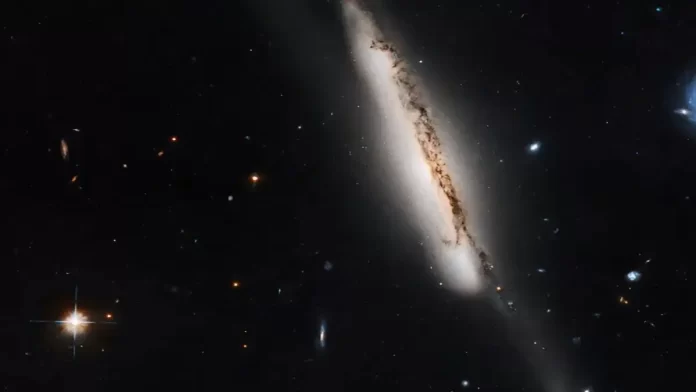A breathtaking cosmic spectacle has been unveiled through a recent image captured by the Hubble Space Telescope, a colossal star bridge stretching an astonishing 250,000 light-years, connecting galaxies within the Arp 295 galactic group. This discovery not only provides a mesmerizing glimpse into the dynamic interplay of celestial bodies but also holds profound implications for our understanding of the Universe’s evolution, potentially offering insights into the distant fate of our own Milky Way galaxy.
Arp 295, situated approximately 270 million light-years from Earth in the Aquarius constellation, comprises a trio of galaxies. The focal point of the Hubble image is Arp 295a, the source of this awe-inspiring stellar bridge, captured in profile against the backdrop of space. Adjacent to it, the vibrant blue spiral galaxy Arp 295c adds to the cosmic panorama.
The origin of this extraordinary celestial phenomenon lies in the gravitational interactions between neighboring galaxies. When galaxies draw near enough to disturb each other’s structure, they enter a phase known as “galactic interaction.” In the case of Arp 295, these interactions have led to the formation of a bridge composed of stars, gas, and dust, stretching between the galaxies. Such interactions can unfold over billions of years as the galaxies graze past each other and intertwine repeatedly.
Over time, these interactions may culminate in a complete merger, transforming the individual galaxies into a single irregular entity. During this merging process, the rate of star formation escalates dramatically, triggering a phenomenon known as “starburst” due to the influx of gas conducive to the birth of new stars.
Furthermore, the supermassive black holes residing at the galaxies’ cores, weighing millions or billions of times the mass of the Sun, are also poised to merge. This cosmic union generates powerful gravitational waves, pivotal for unraveling the mysteries of cosmic evolution.
The study of these interacting and merging galaxies offers invaluable insights into the fate of the Milky Way. Astronomers anticipate that in approximately 4.5 billion years, our galaxy will collide with the Andromeda galaxy, currently situated 2.5 million light-years away. This impending merger could propel our solar system closer to the supermassive black hole Sagittarius A* at the Milky Way’s center or even eject it entirely from the galaxy.
The captivating image captured by the Hubble Space Telescope serves as a testament to the intricate dance of celestial bodies and the ongoing evolution of the cosmos, providing astronomers with a window into the cosmic tapestry that surrounds us.



